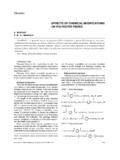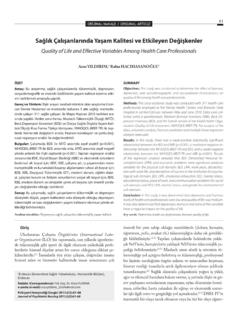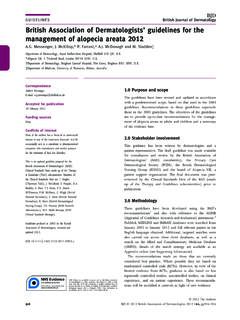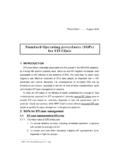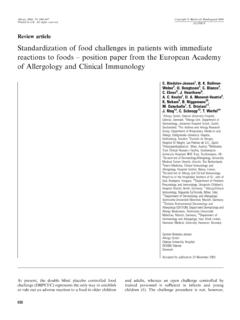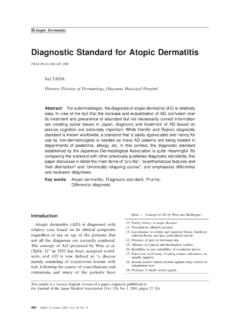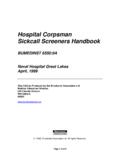Transcription of Association of Periorbital Edema and Fever in …
1 152 OLGU SUNUMU / CASE REPORTA ssociation of Periorbital Edema and Fever in acute infectious mononucleosis : A Case ReportAkut Enfeksiyoz Mononukleozda Periorbital dem ve Ate Birlikteli i: Bir Olgu SunumuKaya H seyin S er1, Asl Feride Kaptano lu21 Department of infectious Diseases and Clinical Microbiology, Near East University Medical Faculty, Nicosia, Cyprus2 Department of Dermatology, Near East University Medical Faculty, Nicosia, CyprusYard. Do . Dr. Kaya H seyin S er, Yak n Do u niversitesi, Yak n Do u Bulvar Lefko a - T rkiye, Tel. 0 392 675 10 00 /2020 Email. Tarihi: Kabul Tarihi: diagnosis and establishment of the etiopathogenesis of Periorbital Edema is important for physicians, particularly the dermatologists and ophthalmologists. It may be the symptom of a broad spectrum of diseases. Although it was defi ned as one of the prodromal signs of infectious mononucleosis (EMN), its occur-rence is rare in clinical practice.
2 In this paper, we reported a 15 year-old female patient, who admitted with Periorbital Edema and Fever , and subsequently diagnosed as EMN and the differential di-agnosis of Periorbital Edema and features of orbital involvement in EMN were words: Edema ; Epstein-Barr virus; eye; Fever ; infectious mononucleosis ZETP eriorbital demin etiyopatogenezinin belirlenmesi ve ay r c tan s klinisyenler, zellikle dermatologlar ve oftalmologlar i in nemlidir. Periorbital dem bir ok farkl hastal n belirtisi olarak g r lebilir. Enfeksiy z monon kleozun (EMN) prodromal belirti-si olarak tan mlanm olmas na ra men klinik uygulamada nadir g r l r. Bu yaz da, Periorbital dem e li inde ate ikayeti ile ba vuran ve EMN tan s alan 15 ya ndaki bir kad n olgu sunumu ile Periorbital demin ay r c tan s ve EMN de orbital tutulumun zellikleri tart lm t r. Anahtar kelimeler: dem; Epstein-Barr virus; g z; ate ; enfeksiy z monon kleozKafkas J Med Sci 2013; 3(3):152 154 doi: and Periorbital Edema may be the symptoms of a broad spectrum of diseases.
3 Both infectious and non- infectious diseases can all lead to Fever and peri-orbital Edema . Since some of these diseases might be emergent, differential diagnosis is critical for proper and immediate intervention1,2. A careful history and physical examination should be performed in order to decide which further tests are needed to clarify the diagnosis. In this report, we aimed to present associa-tion of Periorbital and Fever in a patient fi nally diag-nosed with infectious ReportA 15 year old female patient admitted to the emer-gency department with the symptoms of Periorbital Edema and Fever . She had been experiencing fatigue, mild Fever , sore throat and headache for the last 10 days. Since the Fever had risen higher and associated with Periorbital Edema in the last two days, she de-cided to come to our emergency physical examination, there were some fi ndings including Periorbital Edema , tonsillitis with white membranes, cervical lympadenopathies on ante-rior and posterior chains and hepatosplenomegaly (Figure 1).
4 Her body temperature was C. Quick swab for Strep A was negative. Complete blood count revealed that white blood cells: / mm3, lymphocytes (%69) and monocytes (% ). There was no eo-sinophilia and thrombocytes were / mm3. Immune globulin E was 37 U/L. BUN: 7 mg/dL, 153 Kafkas J Med Scicreatinin: mg/dL. AST: 406 U/L, ALT: 377 U/L, LDH: 550 U/L, CRP: mg/dL. Microscopic examination of the peripheral blood revealed Downey cells (%24). The initial laboratory results were compatible with lympho-monocyto-sis, thus we focused on infectious mononucleosis (EMN). Serologically ELISA tests showed EBV-EBNA Ig G (-), EBV VCA IgM: (+), EBV VCA EA Ig G: (+). A cranial magnetic resonance imaging was performed to rule out other causes of dramatic Periorbital Edema . It was normal other than bilateral subcutaneous Edema in palpebral results confi rmed the diagnosis of EMN and the patient had received symptomatic treatment such as fl uid replacement, paracetamol and anti-infl amma-tory mouthwash.
5 She recovered clinically in 10 Edema may originate from a wide vari-ety of diseases. Associated fi ndings including Fever , nausea, vomiting, and coughing may help in diag-nosis. In addition, the characteristics of the Edema as being localized, diffuse, unilateral or bilateral may also be forms of Periorbital Edema may originate from many reasons, however there are only a few dis-eases causing acute Periorbital Edema . In our patient, the onset of the Periorbital Edema was sudden in a few days, thus we excluded chronic reasons such as nephrotic syndrome or Periorbital Edema in the absence of general Edema is an important clue that is usualy seen in al-lergic reactions (angioedema), trichinosis, Kawasaki disease or bilateral Periorbital reactions like contact dermatitis and angio- Edema should be differentiated at fi rst. In our pa-tient, there were neither a suspicious exogen contact nor erythema or itching.
6 Although angioedema in Periorbital area is a very common cause, our case was not compatible with angioedema since its associa-tion with Fever is not usual. Moreover, angioedema episodes of the Periorbital region usually do not last more than 24 hours. However our patient was expe-riencing Periorbital Edema for the last two days. In addition, there was no history of drug use or suspi-cious food disease may cause Periorbital Edema due to Periorbital vasculitis, however can be differenti-ated by its other systemic features such as onset age and clinical presentation. Trichinosis also may pres-ent with Periorbital Edema , but generalized Edema and, myalgia are dominant clinical presentations with an eosinofi lic shift in peripheral blood count1. Bilateral cellulitis with its acute onset characteris-tic in Association with Fever rarely is seen bilater-ally, however in our case it was excluded by MRI imaging which also helped to exclude a retro orbital tumor as well6, is an infectious disease caused by Epstein-Barr vir s (EBV).
7 Major clinical symptoms are sore throat, Fever , fatigue, anorexia, myalgia, headache and rarely nausea, coughing, vomiting and artralgia. Periorbital Edema is also known to be a symptom of EMN8. However, in textbooks it is not classifi ed as a major and classical symptom of Association of Periorbital Edema with EMN was fi rst described by Hoagland and is referred to as Hoagland sign 10,11. Hoagland et al. reported Figure 1. Bilateral Periorbital Edema in infectious J Med Sciperiorbital Edema in one third of EMN cases in 1952, whereas Mason et al. reported less frequencies in 19588, 1991, Decker et al. reported a case of early EMN with Periorbital Edema . Similar to our patient, their patient was 18 years old and the Edema was presented within the fi rst few days of the disease13. In contrary with the above mentioned cases, in a study dealing with the clinical features of EMN in Turkish chil-dren, the authors did not observe Periorbital Edema in any of their patients14.
8 Ophthalmologic involvement in EBV is unclear. Infl ammation in the lacrimal gland with lympho-cytic infi ltrate was reported and regarded to cause ophthalmic involvement12. In addition, the mucosal Edema in the sinuses was regarded to contribute in Periorbital are also reports of optic neuritis due to EBV3,16,17. In these reports, infl ammation was pres-ent in optic nerve fi bers. Anderson et al. pointed out that all cases of retrobulber neuritis associated with EBV were male patients with an age range of 6 and 29 years. He also noticed that neuritis developed 2-12 weeks following the acute infection and the fi nding suggested an immunologic mechanism3. However, the article did not provide information about the presence of Periorbital Edema or lacrimal gland in-volvement in those Edema may be an alerting symptom of EBV.
9 infectious mononucleosis should be kept in mind if the patients have Association of Periorbital Edema and would like to thank to our patient for providing the informed consent prior to 1. Rafailidis PI, Flags ME. Fever and Periorbital Edema : A review. Surv Ophthalmol 2007; 52(4): 422-33. 2. Scrivener Y, El Aboubi-K hne S, Marquart-Elbaz C et al. Diagnosis of orbito-palpebral Edema . Ann Dermatol Venereol 1999; 126: 844-8. 3. Anderson MD, Kennedy CA, Lewis A et al. Retrobulbar neuritis complicating acute Epstein-Barr virus infection. Clin Infect Dis 1994; 18: 799-801. 4. Kreel L, Poon WS, Nainby-Luxmoore JC. Trichinosis diagnosed by computed tomography. Postgrad Med J 1988; 64: 626-30. 5. Van Hasselt W, Schreuder R, Houwerzijl EV. Periorbital oedema. Neth J Med 2009; 67: 338-9. 6. Wald ER. Periorbital and orbital Infections.
10 Infect Dis Clin North Am. 2007; 21: 393-408. 7. Aidan P, Fran ois M, Prunel M et al. Orbital cellulitis in children. Arch Pediatr 1994; 1; 879-85. 8. Mason WR Jr, Adams EK. infectious mononucleosis ; an analysis of 100 cases with particular attention to diagnosis, liver function tests and treatment of selected cases with prednisone. Am J Med Sci 1958; 236: 447-59. 9. Johannsen EC, Kaye MK. Epstein-Barr virus. In: Mandell GL, Bennett EJ, Dolin R, editors. Principles and Practice of infectious Diseases. 7 th ed. Philadelphia; Churchill Livingstone; 2010: 1988-2010. 10. Burger J, Thurau S, Haritoqlou C. Bilateral lid swelling during infectious mononucleosis (Hoagland sign) Klin Monbl Augenheilkd 2005; 222: 1014-6. 11. Bass MH. Periorbital Edema as the initial sign of infectious mononucleosis .





